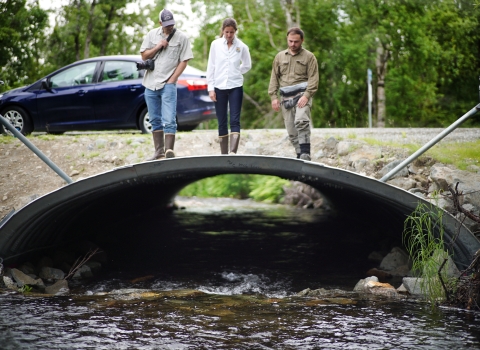Contact: Denise Rowell, denise_rowell@fws.gov, 251-656-3490
The U.S. Fish and Wildlife Service has finalized the recovery plan for fleshy-fruit gladecress, a plant native to cedar glade areas in north-central Alabama that have been significantly altered from their original condition. The plant was federally listed as endangered in 2014.
A winter annual, spring-flowering member of the mustard family, fleshy-fruit gladecress, faces threats from agricultural and urban development and maintenance of transportation rights-of-way. While the conservation efforts of the U.S. Forest Service have reduced threats associated with off-road vehicle use and encroachment of invasive species invasive species
An invasive species is any plant or animal that has spread or been introduced into a new area where they are, or could, cause harm to the environment, economy, or human, animal, or plant health. Their unwelcome presence can destroy ecosystems and cost millions of dollars.
Learn more about invasive species at one site, no existing regulations protect the species on privately owned land, which is where all but one of the remnant fleshy-fruit gladecress populations occur. The small number of populations, compounded by the small size of those populations within the limited range of this species are also substantial threats.
This recovery plan includes specific criteria for determining when the fleshy-fruit gladecress should be considered for delisting and removed from the Federal List of Threatened and Endangered Plants. It also lists site-specific actions that will be necessary to meet those criteria and estimates the time and costs required for implementing actions necessary to achieve recovery. The recovery plan for the plant is now available at the following website:
https://ecos.fws.gov/ecp/species/1435
Recovery will require partnerships and collaboration among various stakeholders. Conservation and management agreements with federal and state departments of transportation, local road departments, railroad authorities, and utility companies and authorities are also needed to ensure protection and necessary management of populations within roadsides and rights-of-way. Collaboration among federal and state conservation agencies, non-governmental conservation organizations, and private landowners and land managers is essential to protect populations on private lands and manage habitat on conservation lands.
Recovery plans are unique to each species and serve as central organizing tools that provide important guidance on methods minimizing threats to listed species, such as restoring and acquiring habitat, conducting surveys, and monitoring populations. Recovery plans also identify measurable and objective criteria so progress can be tracked over time. These plans are guidance and not regulatory documents; no agency or entity is required by the Endangered Species Act to implement actions in a recovery plan.
For more information on the fleshy-fruit gladecress, visit the Service’s Species Profile below or contact Erin Lentz at Erin_Lentz@fws.gov.
For more information: https://www.fws.gov/species/fleshy-fruit-gladecress-leavenworthia-crassa
The mission of the U.S. Fish and Wildlife Service is working with others to conserve, protect, and enhance fish, wildlife, plants, and their habitats for the continuing benefit of the American people. For more information on our work and the people who make it happen, visit https://www.fws.gov/program/southeast-region. Connect with us on social media: Facebook, X (formerly known as Twitter), Flickr, and YouTube.
-FWS


